
Nights into Dreams is a 1996 action game developed by Sonic Team and published by Sega for the Sega Saturn. The story follows the teenagers Elliot Edwards and Claris Sinclair, who enter Nightopia, a dream world where all dreams take place. With the help of Nights, an exiled "Nightmaren", they begin a journey to stop the evil ruler Wizeman from destroying Nightopia and consequently the real world. Players control Nights flying through Elliot and Claris's dreams to gather enough energy to defeat Wizeman and save Nightopia. The game is presented in 3D and imposes time limits on every level, in which the player must accumulate points to proceed.
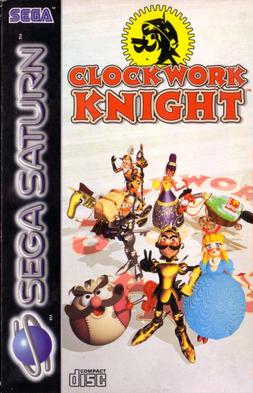
Clockwork Knight is a side-scrolling platform video game developed and published by Sega for the Sega Saturn. It was released in Japan in December 1994, in North America on the 1995 launch, and in Europe on July 8, 1995. Reviews were mixed, with critics praising the advanced graphics but criticizing the low difficulty, short length, and lack of gameplay innovation. It was followed by Clockwork Knight 2.

Pandemonium! is a 1996 platform video game developed by Toys for Bob and published by Crystal Dynamics for the PlayStation, Sega Saturn, Microsoft Windows, N-Gage, mobile and iOS. Pandemonium! features Fargus, a joker, and Nikki, a sorceress, who unwittingly casts a spell that destroys the town. The goal of the game is to reach the Wishing Engine, where they can wish the town back to normal. For each level, the player can choose which character to be. Each has a special move – Fargus can deliver a special spinning attack, and Nikki can double jump. The game consists of a great variety of unique gameplay objects, such as watermelons, clouds, spider webs and logs. A sequel, Pandemonium 2, was released in 1997 for PlayStation and Microsoft Windows.

Mega Man 8 is a platform game developed and released by Capcom in 1996. It was directed by Hayato Kaji and produced by Keiji Inafune, both of whom had previously worked on the series as artists. It is the eighth installment in the original Mega Man series, and was initially released in Japan on the PlayStation in 1996. The following year, Mega Man 8 saw a release on the Sega Saturn and was localized for both consoles in North America and the PlayStation alone in PAL regions. Mega Man 8 is the first game in the series made available on 32-bit consoles. The plot follows series protagonist Mega Man as he is called to investigate an energy reading coming from a recent meteor crash on an island. Mega Man discovers that his nemesis Dr. Wily has run off with the energy source, and sets off to stop Wily's evil plans to use the energy, and to discover the purpose of a mysterious alien robot found at the crash site.

Shinobi Legions, known as Shinobi X in Europe and as Shin Shinobi Den in Japan, is an action game in the Shinobi series developed and published by Sega in 1995 for the Sega Saturn.

Bug! is a platform game developed by Realtime Associates and published by Sega for the Sega Saturn. It was first released in North America, in 1995, weeks after the Saturn's launch there; in Europe on September 15, 1995; and, in Japan, on December 8 the same year. It was also ported to Windows 3.1x and Windows 95 in 1996 by Beam Software. The game is one of the earliest examples of 3D platforming, as well as one of the first platform games released on the Saturn. Character movement is restricted to a track, unlike many in the genre that allow for unrestricted movement in all directions.

The Legend of Oasis, released as The Story of Thor 2 in Europe and as Thor ~Seirei Ou Kiden~ in Japan, is a 1996 action role-playing game developed by Ancient and published by Sega for the Sega Saturn. It is the successor and prequel to the 1994 title Beyond Oasis for the Sega Mega Drive/Genesis. The player takes the role of Leon, who must find the six elemental spirits and use their powers to fight the evil wizard Agito and his legions of creatures.

Dark Savior is a 3D mixed-genre video game for the Sega Saturn created by Climax Entertainment. It was referred to by GameSpot as a sequel to the developer's game for the Sega Mega Drive/Genesis, Landstalker: The Treasures of King Nole, even though the games' storylines are unrelated and their gameplay is considerably different.

Panzer Dragoon II Zwei is a 1996 rail shooter game for the Sega Saturn, published by Sega and developed by Sega's Team Andromeda studio. The second entry in the Panzer Dragoon series and a prequel to the original game, the story follows Lundi and his dragon companion, Lagi, as they pursue an airship of the Ancient Age. The player controls an aiming reticle representing the dragon's laser and Lundi's gun, shooting enemies while the dragon travels through 3D environments on a fixed track. Levels can have multiple pathways, and the dragon grows stronger over the course of the game based on the player's score.

Shining the Holy Ark (シャイニング・ザ・ホーリィアーク) is a first person role-playing video game released in 1997 for the Sega Saturn. It is a part of Sega's Shining series of video games, and marked a new direction for the series, utilizing polygons as well as sprites for the visuals and a story targeted more specifically towards an adult audience. It introduced the saga of the Vandals and the Innovators, abandoning the saga of the Devil Kings which was followed by the previous installments of the series.
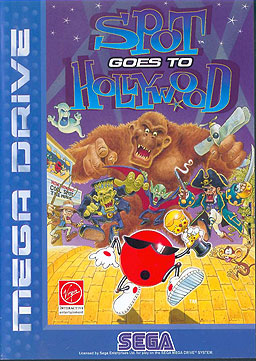
Spot Goes to Hollywood is a platform game developed by Eurocom and published by Acclaim Entertainment in North America and Virgin Interactive Entertainment in Europe for the Mega Drive/Genesis as the sequel to Cool Spot. Saturn and PlayStation versions were later released with full motion video clips and isometric graphics. The player controls Spot, once the mascot for the 7 Up soft drink, as it travels to various places trying to free its friends.

Worms is a 2D artillery tactical video game developed by Team17 and released in 1995. It is the first game in the Worms series of video games. It is a turn based game where a player controls a team of worms against other teams of worms that are controlled by a computer or human opponent. The aim is to use various weapons to kill the worms on the other teams and have the last surviving worm(s).

Panzer Dragoon is a series of video games developed by Sega. The first three games—Panzer Dragoon (1995), Panzer Dragoon II Zwei (1996), and Panzer Dragoon Saga (1998)—were produced by Sega's Team Andromeda for the Sega Saturn. The fourth, Panzer Dragoon Orta (2002), was developed by Sega's Smilebit team for the Xbox. Spin-offs include Panzer Dragoon Mini (1996) for the handheld Game Gear in Japan. A remake of Panzer Dragoon was released in 2020.

Krazy Ivan is a mecha first-person shooter released for PC, Sega Saturn and PlayStation in 1996 by Psygnosis.
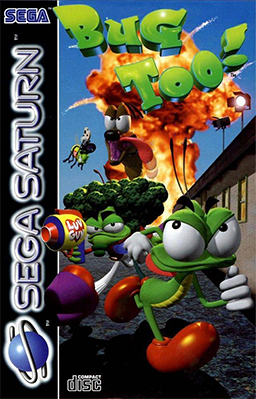
Bug Too! is a side-scrolling platforming video game developed by both Realtime Associates and SegaSoft. It is the sequel to Bug!, which was developed and published by Realtime Associates and Sega. It was first released for the Sega Saturn on November 30, 1996 in North America. It was later ported to Windows devices on December 10 of the same year in both North America and PAL regions. Finally, it was released in PAL regions for the Sega Saturn on April 24, 1997. Players are given the option of choosing from Bug, Maggot Dog, or Super Fly, a trio of action movie stars, who must proceed through a series of mostly 2D levels across multiple zones, with a boss level at the end of each zone.

Lost Vikings 2 is a 1997 puzzle-platform game developed by Beam Software and published by Interplay. All versions of the game, except the SNES release, were titled Lost Vikings 2: Norse by Norsewest. The sequel to The Lost Vikings, it features the original three characters plus two new playable characters: Fang the werewolf and Scorch the dragon. The gameplay remains largely the same, though the three Viking characters all have new or modified abilities.
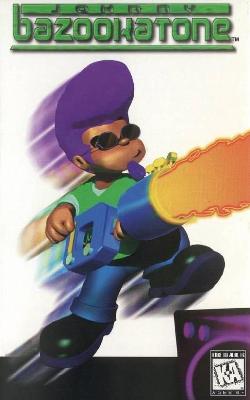
Johnny Bazookatone is a platforming video game developed by Arc Developments and published by U.S. Gold for the 3DO, PlayStation, Sega Saturn, and MS-DOS computers in 1996. Some releases also came equipped with a music CD based on the game's musical score. The game follows the protagonist, Johnny Bazookatone, trapped in the year 2050 in Sin Sin Prison by El Diablo, lord of the underworld. His guitar, known as "Anita" is taken from him, and so Johnny must travel to reclaim it.
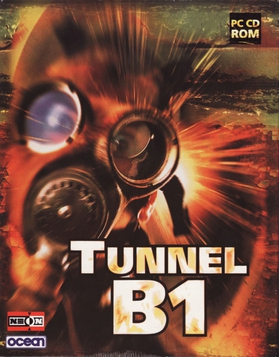
Tunnel B1 is a first-person shooter developed by NEON Software and published by Ocean Software in 1996. The soundtrack is by Chris Huelsbeck who also scored Turrican. The PlayStation and Sega Saturn ports were released in Japan as 3D Mission Shooting: Finalist.

Sky Target is a 1995 arcade game by Sega. A rail shooter featuring a number of planes including the default F-14D Super Tomcat, it is best remembered for its semi-official connection to Sega's earlier hit After Burner. Although never billed as a sequel, its overt similarities to the 1987 classic were nonetheless referenced in official promotional materials and recognized by the media. Plus, it features a revised version of the "After Burner" music theme within its soundtrack.

Three Dirty Dwarves is a 1996 beat 'em up video game developed by Appaloosa Interactive and published by Sega for their Sega Saturn console. It was later ported to PC.




















